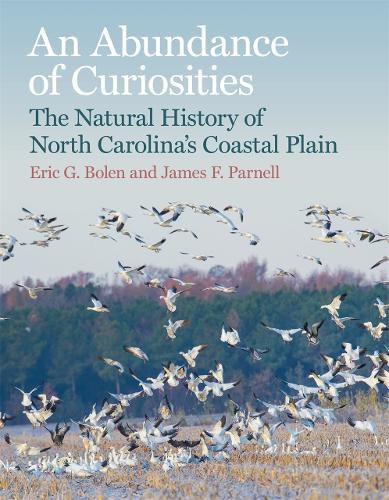Readings Newsletter
Become a Readings Member to make your shopping experience even easier.
Sign in or sign up for free!
You’re not far away from qualifying for FREE standard shipping within Australia
You’ve qualified for FREE standard shipping within Australia
The cart is loading…






A popular tourist area, North Carolina’s coastal region is the destination of roughly 25 percent of all North Carolina visitors each year, or approximately 12.1 million people. Composed of twenty-eight of the eastern-most counties of North Carolina, the Coastal Plain is the largest and most diverse of the state’s three biogeographical regions.
Beginning with an overview of early naturalists who marveled at the region’s natural treasures, Eric G. Bolen and James F. Parnell’s natural history of the Coastal Plain offers a nature-focused walk through the distinctive geological features and plant and animal communities of the area that extends from the Fall Line (delineated approximately by I-95) to the shores of the Atlantic Ocean.
This richly illustrated volume presents a journey that begins with the Outer Banks and their beaches, dunes, wild horses, and maritime forests, then moves on to describe the form and functions of the region’s extensive salt marshes. The text continues with visits to the mysterious Carolina bays, Lake Waccamaw, dark cypress swamps, the Great Dismal Swamp, and blackwater streams. Along the way, readers will discover the habitat-and concern-for the last remaining wild population of red wolves and the recently established nesting colonies of wood stork. Rivers and sounds, highlighted by seagrasses, bottomland forests, and eel migrations, come next, followed by a tour of uplands, where bogs of carnivorous plants dot wet savannahs; also presented are the Carolina Sandhills with their stately forests of longleaf pine, colorful tree frogs, burrowing snakes, and unique fishes. To conclude, an afterword discusses the reasons for saving endangered species.
Infoboxes scattered throughout the text offer stand-alone explorations of historical and cultural topics associated with North Carolina’s Coastal Plain. Subjects such as whaling, waterfowl decoys, the chanteys of menhaden fisherman, fire ecology, and the extinction of Carolina parakeets illustrate the breadth of coverage. For reference, an appendix cites the scientific names of species mentioned in the text, and a list of readings and references appends each chapter.
$9.00 standard shipping within Australia
FREE standard shipping within Australia for orders over $100.00
Express & International shipping calculated at checkout
A popular tourist area, North Carolina’s coastal region is the destination of roughly 25 percent of all North Carolina visitors each year, or approximately 12.1 million people. Composed of twenty-eight of the eastern-most counties of North Carolina, the Coastal Plain is the largest and most diverse of the state’s three biogeographical regions.
Beginning with an overview of early naturalists who marveled at the region’s natural treasures, Eric G. Bolen and James F. Parnell’s natural history of the Coastal Plain offers a nature-focused walk through the distinctive geological features and plant and animal communities of the area that extends from the Fall Line (delineated approximately by I-95) to the shores of the Atlantic Ocean.
This richly illustrated volume presents a journey that begins with the Outer Banks and their beaches, dunes, wild horses, and maritime forests, then moves on to describe the form and functions of the region’s extensive salt marshes. The text continues with visits to the mysterious Carolina bays, Lake Waccamaw, dark cypress swamps, the Great Dismal Swamp, and blackwater streams. Along the way, readers will discover the habitat-and concern-for the last remaining wild population of red wolves and the recently established nesting colonies of wood stork. Rivers and sounds, highlighted by seagrasses, bottomland forests, and eel migrations, come next, followed by a tour of uplands, where bogs of carnivorous plants dot wet savannahs; also presented are the Carolina Sandhills with their stately forests of longleaf pine, colorful tree frogs, burrowing snakes, and unique fishes. To conclude, an afterword discusses the reasons for saving endangered species.
Infoboxes scattered throughout the text offer stand-alone explorations of historical and cultural topics associated with North Carolina’s Coastal Plain. Subjects such as whaling, waterfowl decoys, the chanteys of menhaden fisherman, fire ecology, and the extinction of Carolina parakeets illustrate the breadth of coverage. For reference, an appendix cites the scientific names of species mentioned in the text, and a list of readings and references appends each chapter.